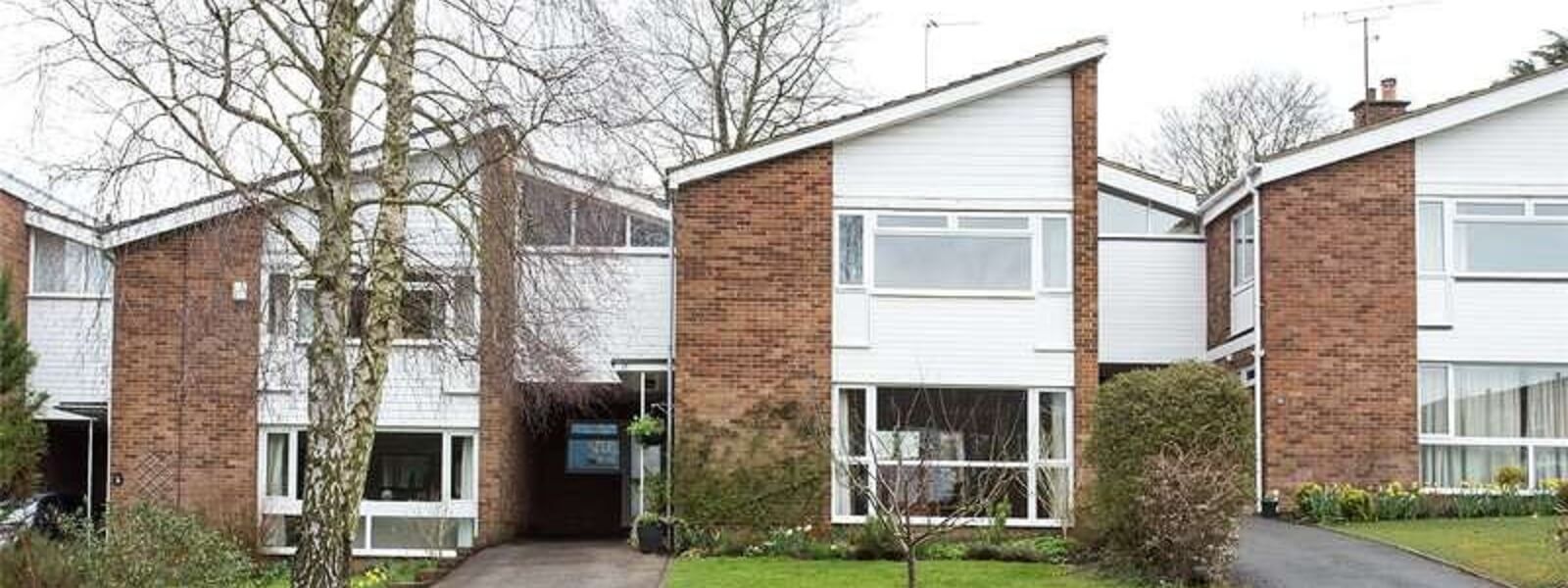Stanley Comben of building firm Comben and Wakeling
by Alison Bailey, Jill Carr, Liz Hutchins, and Martin Pounce


Stanley Comben first moved to the Amersham area around 1940 when he moved to Capesthorne, Bois Lane, Chesham Bois where he lived with his family until 1954. They then moved to The Dial House, on the corner of Chestnut Lane and Sycamore Road, Amersham-on-the-Hill. In 1970, after semi-retiring he left Amersham and moved to 9 Astons Road on the Moor Park Estate. He was a member of the well-known Comben family of builders, who as Comben and Wakeling built much of north west London, particularly North Wembley and Wembley Park.
Stanley Albert Comben was born in 1909 in Fulham. Born to James and Mary (née Wakeling) Comben, he was the youngest of six surviving children (three girls and three boys). Another brother, Alan, followed in 1913. His father James Comben was born in 1864 in Portland, Dorset. After his apprenticeship as a stonemason, James moved to Fulham, London and initially worked as an insurance agent. Here he became friends with William Henry Wakeling through the local Methodist church. In 1890 James married William’s sister, Mary and the following year the two brother-in-laws decided to go into business together.
Their first business was a grocery shop in Fulham which was so successful they opened two more. Encouraged by the success of this business the partners decided to use James’ skills as a stonemason and William’s previous experience as a clerk in a builder’s office to expand into the building trade. James Comben had seen an opportunity to fully fit out new build houses. In the early 1900s houses were usually sold as shells without plastering, plumbing or decoration and James wanted to offer a full service. The new idea of a completed house caught on and the grocery business was sold off. Comben and Wakeling was founded as a building company in 1904. To ensure the company’s success both partners worked from six-thirty in the morning until ten o’clock at night, with no bank holidays or Saturdays off. Being fervent Methodists Sunday was a day of rest.
Comben and Wakeling was incorporated as a private limited company in 1924 and by 1936 the firm had built thousands of houses in Wembley. It became a public company in 1965 when they had 590 members of staff. In 1979 the company, now called Comben Homes, celebrated its 75th year Anniversary. At that time the firm had eight operating regions in the UK and two overseas offices. In 1984 the company was acquired by Trafalgar House and integrated into its Ideal Homes housebuilding business.
Comben and Wakeling were pioneers in suburban housing, building houses for working class people that were affordable on an average wage. They introduced bathrooms into working class dwellings and were part of the Garden City Movement. In total they built over six thousand homes in Wembley having made their first large purchase of land at Wembley Park in 1914 but they also planted over half a million shrubs and ten thousand trees. Over the years the company’s activities extended into Ealing, Finchley, Pinner, Harrow, Ruislip and Bushey, expanding with the underground until they arrived in Amersham and Chesham in the 1950s and then went nationwide.
The company name was associated with quality building and attention to detail such as “three hinges to each door”. Estate agents continued to promote properties as a “Comben and Wakeling house” well into the 1990s. This is an advertisement from the Buckinghamshire Examiner of 19 November 1965:


Mary Wakeling, known as Polly by the family, was born in East Grinstead in 1864. When she met James Comben in Fulham she was working as a pupil teacher, as was her sister, Martha. They were both keen Methodists and brought up their seven children (an eighth died in infancy) in the Methodist faith. At the beginning of WWI, she joined the St John Ambulance Brigade and served as a volunteer nurse (a VAD) at Willesden. She continued to do ambulance work until she was over 70.
The success of Comben and Wakeling meant that the family was able to move to a grand house, Dagmar House, Park Lane, Wembley in lovely grounds. The Wakelings also lived here for a time before moving to another mansion called Tudor House on adjacent land. The houses had unobstructed views across to Harrow-on-the-Hill. Sadly, both houses have since been demolished. Stanley, his siblings and cousins had a privileged upbringing in Wembley and were all well educated. Stanley and Alan went to Kingswood, the private school founded by John Wesley in Bath. Entry had been restricted to the sons of Methodist ministers and they were among the first to attend when this restriction was listed.
At Dagmar House Mary held garden parties to raise funds for various good causes such as her church, the Red Cross, and the Wembley Rotary Club of which James was the founder president in 1930. Stanley was also a founder member of Kingsbury and Kenton Rotary Club and president of the club in 1951-52.
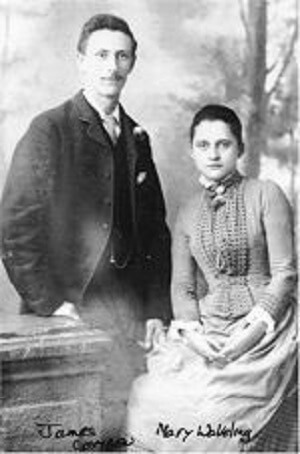
Stanley’s eldest brother, Horace, gained a Bachelor of Science in Civil Engineering at the University of London and became an Associate Member of the Institution of Civil Engineers whilst working as a civil servant. He left the Civil Service when he took up his directorship of Comben & Wakeling in 1926. Stanley followed Horace to the University of London where he studied architecture and town planning. He then followed Horace into the family firm.
In 1931 James Comben died from pneumonia following surgery. William Wakeling became chairman of the company and Horace was elected a member of the board. In 1944 he became President of the National Federation of House Builders. This was an organisation formed in 1939 to combat ‘Jerry Building’ The organisation was closely linked with the National House Builders Registration Council and the Ministry of Health. He was awarded the C.B.E. for these services. He later became chairman of Comben and Wakeling before retiring to Bournemouth in the 1960s, when Stanley took over as chairman of the company.
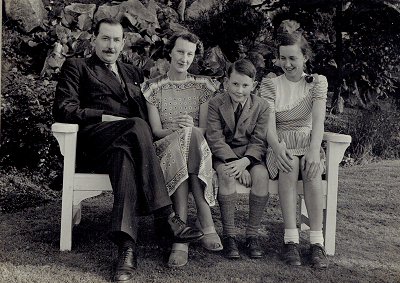
In 1934 Stanley married Stella Phyllis Rogerson, the daughter of an electrical engineer from Ponders End, Enfield and they lived together in Eastcote where their daughter, (Gillian) Mary was born. Late 1939 or early 1940 Stanley and Stella moved the family further out of London, presumably for a safer environment out of the reach of the German bombers as their son David John Chesham was born in Amersham in the autumn of 1940. Stanley’s uncle William Wakeling (the Chairman of Comben and Wakeling) had recently moved to Chesham Bois with his wife, Emmeline, daughter Muriel and her husband Arthur Moore. There was also a parlour maid, Mabel Scott living with them according the 1939 Register. Their large house, Capesthorne on Bois Lane, became the Comben family home until 1954, after the Wakelings decided to decamp to Colwyn Bay. Jill remembers it as a dark dismal house and rather frightening to a little girl! In 1954 Stanley and Stella moved the family again, but this time less than a mile down the road. Their new house was The Dial House on the corner of Chestnut Lane and Sycamore Road and just over the border into Amersham.

From 1942 to 1945 Stanley served as a 2nd Lieutenant in the Royal Engineers.
According to the 1979 booklet Comben Homes celebrate their 75th Anniversary; “All house building stopped at the outbreak of war in 1939. The company went on active service building airfields – 12 were built in East Anglia at one time. In London there was much activity repairing war damage. Air raid shelters were built in school playgrounds, down residential roads and in shopping areas. After the war the company’s expertise was called for in new fields – they were awarded the contract to build the running track for the Olympic Games at Wembley. Within a few years activities included building banks, churches, a garage, a bus station and blocks of flats, in addition to houses”.
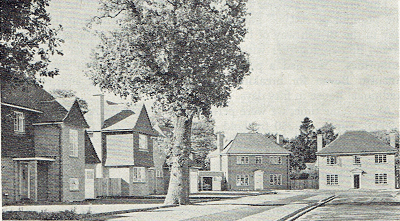
After the war Comben and Wakeling expanded their business further out into the Chilterns. Detached houses were built in Clifton Road and Green Lanes, Chesham Bois. In the mid-1950s Comben and Wakeling bought the Beech Barn Camp land. This was a former army camp where families had been living in refurbished Nissen huts since the end of WWII. Here the firm built The Leys, a cul-de-sac of new houses. In 1953 they acquired part of the Tenterden Estate. They initially built a handful of houses, including a house for one of their directors, but gradually they built a small estate of detached homes which is now The Grove and The Ridings. This ad was placed in the Buckinghamshire Examiner 20 July 1962:
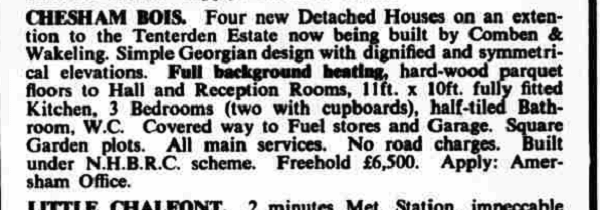
The 1960s saw a rapid expansion of Comben and Wakeling homes in our area, particularly in Chesham where the company built flats, maisonettes, and town houses, and an estate of semi-detached properties with garages in Great Hivings. In 1964, the 60th anniversary of the founding of the company, they built the car showroom in London Road, Old Amersham which was most recently Lookers Jaguar before it closed in 2019.
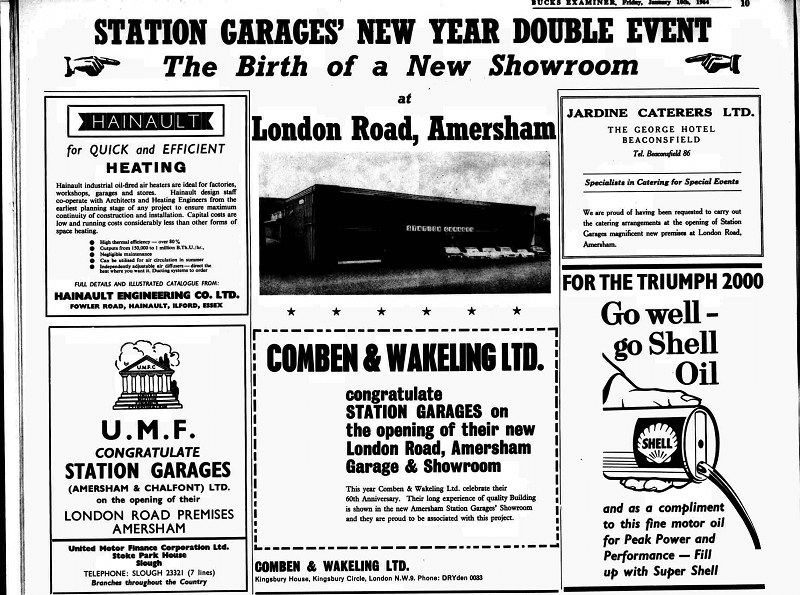

Highover Park in Old Amersham is probably the company’s best-known development in our area. Controversial at the time because of the proximity to Amyas Connell’s High and Over and the Sun Houses, work started on the 16-acre site in 1965 with a second phase released in 1966. The mid-twentieth century design, landscaping and lovely views still mean that houses on the estate are highly sought after.

Stanley Comben followed his father’s footsteps into local government. James Comben had been a councillor and chairman of the former Wembley Urban District Council. In 1958 Stanley was first elected to Bucks County Council as a Conservative councillor representing the Amersham-on-the-Hill, Amersham Common and Little Chalfont Wards. He served on the council, becoming chairman of its planning committee in 1967 until his retirement in 1970. Perhaps surprisingly for a nationwide housebuilder, he was a champion of the countryside and campaigned in 1964 for the designation of the Chilterns as an Area of Outstanding National Beauty. According to an article in the Buckinghamshire Examiner of 3 March 1967 “Mr Stanley Comben was recently given an opportunity of explaining to the Queen and Prince Philip the need for preserving the Bucks Green Belt by channelling new industry to the new town of Milton Keynes and of flying with the Minister of Housing and Local Government over the Chilterns to show him the county’s Green Belt needs”.

Like most members of his family, Stanley was a keen Methodist. Comben and Wakeling were responsible for building several Methodist Churches. They built Park Lane Church in Wembley in 1925 and then its replacement in 1962, Eastcote Methodist Church during the 1950s (they donated the land in 1939 but war intervened), Chesham Methodist Church in 1966, Gerrard’s Cross Methodist Church in 1963, Little Chalfont Methodist Church in 1959 (this building was subsequently damaged in a fire and a new church opened in 1996), and the St John’s Methodist Church in Woodside Road Amersham in 1960. The distinctive modernist design, with church and rooms set on three sides of a central garden, was by architect Alister Macdonald, the son of James Ramsay Macdonald who had a weekend cottage in nearby Bois Lane. The Combens held garden parties at The Dial House to fundraise for the new building and on 2 April 1960 St. John’s Church was opened by Mrs Stella Comben and dedicated by Reverend Lawrence Brooker in the presence of Rev Dr Eric Baker, then President of the Methodist Conference, who preached the sermon.
When the old Park Lane Church was demolished in Wembley in 1961, Stanley and his brother saved the pulpit, and the panelling from the memorial to their mother Mary who had died in 1957. This was donated to the Amersham High Street Methodist Church. Stanley was a Circuit Steward for the Amersham Circuit.
Stanley and Stella left The Dial House and moved to the Moor Park Estate in 1970 when Stanley retired from the business but a couple of years later, they moved again to Hill House, Ormesby St Margaret, near Great Yarmouth, Norfolk. Here Stanley was supposed to fully retire but he still retained a professional and family interest in a Yarmouth firm of builders! Sadly, just two years later in 1974, age 65, Stanley died. Stella returned to North London and died in Northwood in 1986.

Sources
1979 booklet Comben Homes celebrate their 75th Anniversary
www.britishnewspaperarchive.co.uk
www.bigenealogy.com/wallis The Complete Story of the Wallis’s by Bob Wallis
The Methodist Church, High Street, Amersham, Bucks A Brief History from 1818 by Ray Richards
https://www.plmc.org.uk/about-us-1/history-of-park-lane/ Park Lane Methodist Church
The Incorporated Auctioneers Journal October 1961
The Metroland Dream – Your Comben & Wakeling home in Wembley by Philip Grant https://wembleymatters.blogspot.com/2019/01/guest-post-by-philip-grant-i-dont-often.html

